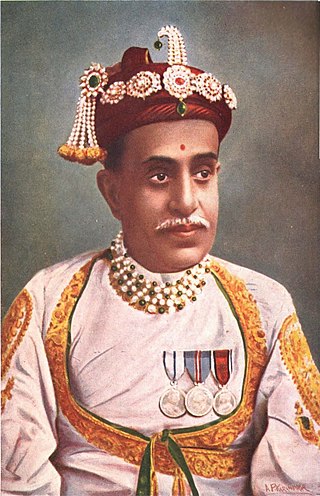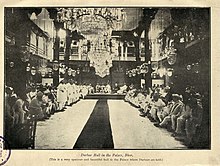
The Peshwa was second highest office in the Maratha Confederacy, next in rank and prestige only to that of the Chhatrapati. Initially serving as the appointed prime minister in the Maratha empire, the office became hereditary after the death of Shahu in 1749. During the reign of Shahu, the office of Peshwa became incredibly powerful and the Peshwas came to be the de facto rulers of the Maratha empire. However following the defeat of the Marathas in 1761, the office of the Peshwa became titular as well and from that point onwards served as the ceremonial head of the Confederacy underneath the Chhatrapati.
Karhaḍe Brahmins are a Hindu Brahmin sub-caste mainly from the Indian state of Maharashtra, but are also distributed in states of Goa, Karnataka and Madhya Pradesh.
Bhor is a town and a municipal council in Pune district in the state of Maharashtra, India.
Pant or Panta is a last name, commonly found in Nepal and in the Indian states of Uttarakhand and Maharashtra. It is a traditional surname used by Brahmins, a priestly community. Foremostly involved in the activities of the state, they were generally found involved in activities such as academics, religion, management, politics and warfare.

Ramchandra Neelkanth Bawadekar (1650–1716), also known as Ramchandra Pant Amatya, served on the Council of 8 as the Finance Minister (Amatya) to Emperor (Chhatrapati) Shivaji, dating from 1674 to 1680. He then served as the Imperial Regent to four later emperors, namely Sambhaji, Rajaram, Shivaji II and Sambhaji II. He authored the Adnyapatra, a famous code of civil and military administration, and is renowned as one of the greatest civil administrators, diplomats and military strategists of the Maratha Empire.
Shankaraji Narayan Gandekar (1665–1707), also known as Shankaraji Narayan Sacheev or Shankaraji Narayan, was a popular Minister (Pradhan) and Count (Sardar) of the Maratha Empire. He also served as Imperial Secretary (Sacheev) during Rajaram's reign. He also served as Deputy to the Crown (Rajadnya) under Emperor Sambhaji. His contribution to the war of independence against Mughal rule is considered to be immensely supportive. He was also the founder of the princely state of Bhor located, in Pune district.
Parshuram Trimbak Kulkarni (1660–1718), popularly known as Parshuram Pant Pratinidhi, was a Minister (Pradhan) and Count (Sardar) of the Maratha Empire. He served as Pratinidhi during Rajaram I and Tarabai’s reign. His contribution to the War of 27 years is considered to be of vital importance. He was also the founder of the princely states of Vishalgad and Aundh in Maharashtra.
Pant Pratinidhi family is a prominent aristocratic noble family of India, who served as Pratinidhis to Chhatrapatis of Maratha Empire and later became rulers of the Princely states of Aundh and Vishalgad.

Aundh State was a Maratha princely state during the British Raj, in the Deccan States Agency division of the Bombay Presidency.

Bhor State was one of the 9-gun salute Maratha princely states of Deccan States Agency. It was the only state belonging to the Poona Agency under the Bombay Presidency, which became later part of the Deccan States Agency. Along with Akkalkot State, Aundh State, Phaltan State and Jath State, it was one of the Satara Jagirs. The state merged with the newly independent Indian union in 1948.

Chandrashekhar Govind Agashe was an Indian industrialist and lawyer, best remembered as the founder of the Brihan Maharashtra Sugar Syndicate Ltd. He served as the managing agent of the company from its inception in 1934 till his death in 1956. He served as the President of the Bhor State Council from 1932 to 1934.
The Pratinidhi was an important member of the ministry in the Maratha Empire. The title of Pratinidhi means the representative of the King, and such officials were entitled to sign and seal papers and to issue orders in the absence of the Ruler. Shivaji's ministry of the eight - the Ashta Pradhan did not include a Pratinidhi. Later the post of Pant Pratinidhi was created during the Rajaram I reign and a person holding this office exercised powers over all ministers of the Maratha court including the Peshwas. Above the Ashta pradhan Rajaram I appointed Pralhad Niraji to the high post of Prathinidhi. The office of Pratinidhi was created and the office of Peshwa was made next to it in hierarchy. The first occupant of the position under Rajaram was Pralhad Niraji, who was appointed in 1689.

Raja Sir Raghunathrao Shankarrao GandekarKCIE, KGSJM, KECM, KGCM, DD was the 11th ruler of the princely state of Bhor of British Raj during the reign (1922–1951). During his reign, he implemented many reforms such as abolition of untouchability, freedom of association and introduction of representative government. He signed the accession to the Indian Union on 8 March 1948 which ended the separate existence of Bhor state.
The Sachiv was an important member of the ministry in the Maratha Empire. Sachiv was one of the Ashta Pradhans of Maratha Empire during the rule of Chitrapathi Shivaji. Later during the reign of Rajaram I, the office became hereditary like most of the others instituted by Shivaji. Shankaraji Narayan Pant Sachiv, who was appointed to the post in 1698 by Rajaram I was a hereditary Pant Sachiv. The Pant Amatya and The Pant Sachiv were the most powerful civil functionaries in the Maratha Empire next to the Peshwa until the death of Shahu I.

Shrimant Raja Shankarrao Chimnajirao Gandekar, was the 10th ruler of the princely state of Bhor of British Raj during the reign.
Shrimant Naro Shankaraji Gandekar Pant Sachiv was a Sardar of the Maratha Empire. He was the hereditary Pant Sachiv during Chhatrapati Shahu I reign. After the death of his father Shankaraji Narayan Sacheev in 1707, Naro Shankar won the favour of Shahu by fighting many battles in the defence of the Maratha Empire. In 1707 Shahu confirmed the Jagir of Shankaraji Narayan Sacheev to his son Naro Shankar and the hereditary title Pant Sachiv. He was the 2nd ruler of the princely state of Bhor during the reign (1707–1737).

Bhor Rajwada is a historical palace and a royal residence at Bhor in the Maharashtra state of India. It was the official residence and the seat of the Rajas of the Princely State of Bhor. The Bhor Rajwada palace is a synergy of Indian Vernacular and European Renaissance Architectural style and was built by Chimnaji Rao III at a cost of INR 2 lakh in 1869.

Purandare is prominent Indian family of Nobles, Sardars, Patil, Jagirdars during Maratha Empire. They belong to Deshastha Rigvedi Brahmin (DRB) community. Dhondo Malhar Purandare, a member of purandare family held the patilki watan of Vadule, a village in present day Shevgaon taluka in Ahmednagar district. Purandare wada (palace} in Saswad was the seat of the Purandares until 1818, when the Peshwas lost control to the British East India Company after the Third Anglo-Maratha War.The Purandare Wada still stands but is in a much dilapidated state. The design of the Purandare wada was the inspiration for the better known Shaniwar Wada in Pune.










